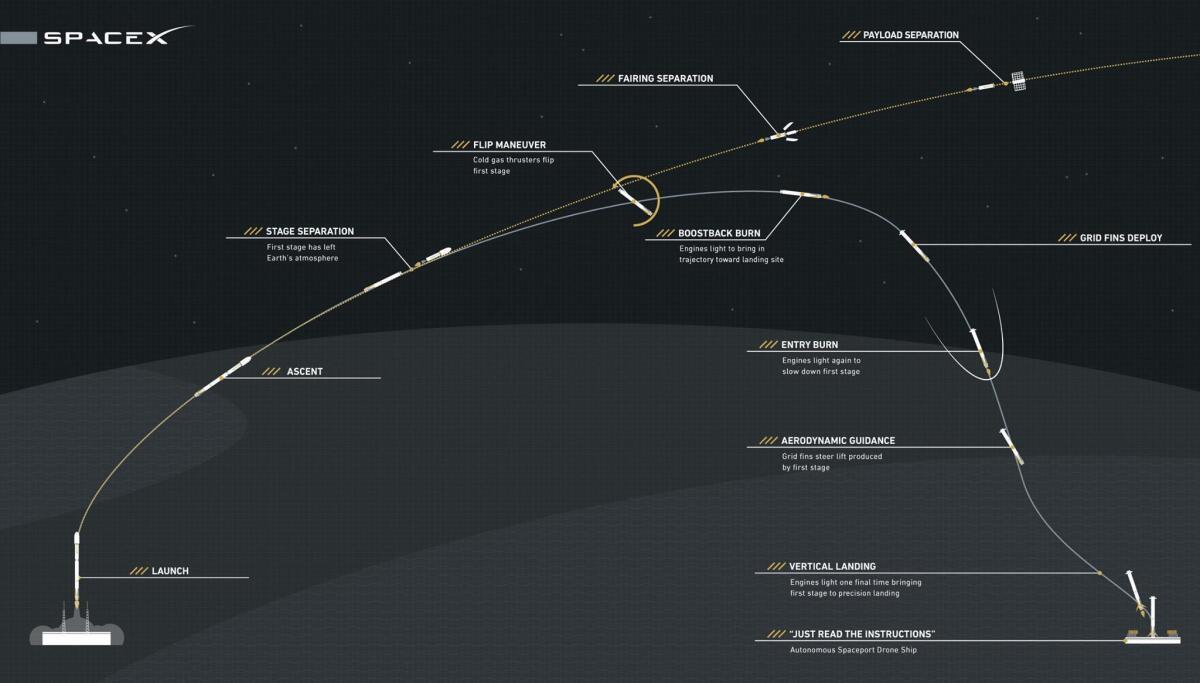SpaceX rocket stage fails to land on drone ship
- Share via
Elon Musk's SpaceX managed to launch a satellite into orbit Sunday, but suffered another setback in its attempt to retrieve a rocket stage by landing it on a sea-going platform.
SpaceX officials said the Falcon 9 rocket first stage experienced a "hard landing" and broke one of its stabilizer arms designed to hold it upright.
The rocket stage was left in pieces on the deck of the drone ship landing pad, and Musk quipped via Twitter that "as least the pieces were bigger" this time.
The final moments of the landing showed the stage approaching in a perfectly vertical position, according to a tweet by @SpaceX
This was the third time the Hawthorne-based company failed to accomplish a clean sea landing, although the company brought a Falcon rocket stage back to terra firma at Cape Canaveral, Fla., on Dec. 21, in what many hailed as an significant engineering feat.
Live coverage of launch:
Sunday’s effort was far more difficult, and flight announcers minimized expectations from the start, pointing out the engineering difficulties of the "experimental" attempt to land on a drone ship named Just Read the Instructions, about 200 miles off Southern California.
“Just to re-emphasize: this is a test that we’re doing today,” said Kate Tice, a SpaceX engineer who co-hosted the live broadcast. “If we land successfully or not, we’re going to get some really important data from the landing attempt today.”
A live shot from Just Read the Instructions froze soon after it was announced that the landing legs of the rocket stage had deployed – a final maneuver before its touchdown attempt.
About 15 minutes later, SpaceX announced the failed landing attempt.
“As we touched down, it was a slightly harder landing than we expected and it looks like one of the landing legs may have broken as we touched down on the drone ship,” Spacex lead mechanical design engineer John Federspiel said. “Unfortunately we are not standing upright on the drone ship at the moment.”
The full round trip has been compared to vaulting a pencil over the Empire State building, then getting it to come back and land on its eraser atop a floating target smaller than a shoe box, and not tip over.
See the most-read stories this hour >>
SpaceX has yet to reuse a rocket stage, a key element in bringing the cost per launch to a level at which the company could dominate the market for delivering cargo and people to space.
Physics, politics and economics all necessitated the water landing, a highly complicated feat with a narrow margin for error. Shortening the return trip was the easiest way to balance the requirements to deliver a heavy satellite at the high speed needed to reach a distant orbit, then put on the brakes, flip the first stage around, guide it through Earth’s atmosphere, and get it to touch down gently. The landing zone measured about 300 feet by 170 feet, according to SpaceX.
Hurling a pencil over the Empire State building

The maneuvers involved in bringing the Falcon 9 rocket booster back to Earth
The physics of the Falcon 9 flight. (SpaceX)
In any case, the company did not receive timely clearance from federal agencies to bring it back to land.
Fortunately, one of the U.S. agencies that cares about hazards to sea life is a client: The Jason-3 satellite aboard the launch vehicle is a joint endeavor of the National Oceanic and Atmospheric Administration, its European counterpart, NASA and the French space agency. It is designed to measure ocean surface topography to better understand sea level rise, currents and weather phenomena such as El Niño.
See more of our top stories on Facebook >>
Stabilizing the 14-story rocket alone is akin to balancing a broomstick on your palm, according to SpaceX engineers.
Musk faced little downside in attempting a water landing, said Marco Caceres, senior space analyst for Teal Group Corp., a defense and aerospace analysis company based in Fairfax, Va.
A privately held company, SpaceX apparently is flush with money and just won a new NASA contract, he noted.
“You’re testing reusable technology. It’s expected that you’ll have your share of failures,” Caceres said. “They don’t seem to be afraid of that. Other companies seem to be a bit more tentative.”
The public, however, has not accustomed itself to the failures that once were relatively common in the early days of the publicly funded space exploration program, Caceres said.
“A company comes up with a new rocket and they may have one or two tests and then they start operational launches,” he said. “I, as an analyst, fully expect a company to have many failures. ”
Twitter: @LATgeoffmohan
ALSO
Olympus to recall and redesign medical scope linked to superbug outbreaks
Fears rise that plunging U.S. stocks could pose risk to economy if volatility continues
These top-selling dresses at Macy's, Kmart and Wal-Mart show us what retail got wrong
UPDATES
06:35 p.m.:This article has been updated with a tweet from @SpaceX.
05:55 p.m.: This article has been updated with information on the crash landing and a tweet from Elon Musk.
This article was originally published at 2:47 p.m.
Inside the business of entertainment
The Wide Shot brings you news, analysis and insights on everything from streaming wars to production — and what it all means for the future.
You may occasionally receive promotional content from the Los Angeles Times.








